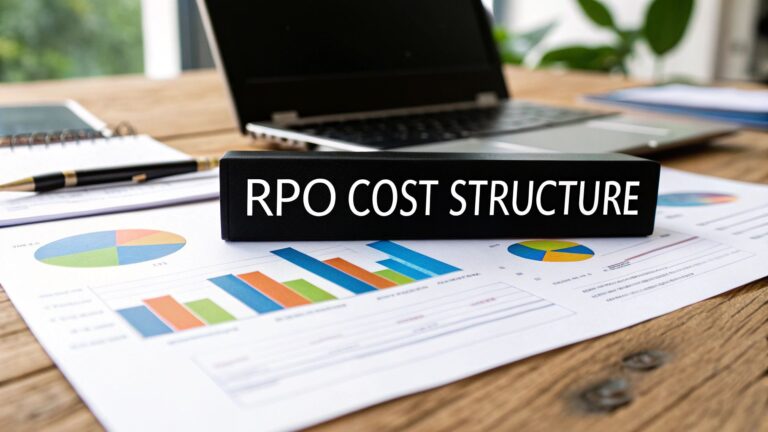Project Manager Roles and Responsibilities: Behind every successful business initiative, be it a product launch, a digital transformation, or a nationwide hiring campaign- there’s a Project Manager steering the effort with precision and purpose.
Project Managers are not just task coordinators. They are strategic thinkers, problem-solvers, and team leaders who turn complex plans into real outcomes. Their ability to manage time, teams, and resources effectively is what helps organizations move from vision to execution.
For companies experiencing rapid growth or managing large-scale operations through Recruitment Process Outsourcing (RPO), the role of a Project Manager becomes even more critical. These professionals ensure that every phase of a project aligns with business goals, stays within budget, and delivers value on time.
It’s important to distinguish between a Project Manager and a Project Management Office (PMO). While the PMO sets the standards and governance models, the Project Manager brings those frameworks to life by actively leading day-to-day execution.
In this blog, we explore the key responsibilities of a Project Manager, the skills they need to succeed, how they differ from the PMO, and why hiring the right PM can directly impact business success- especially in fast-paced, talent-driven industries.
What is a Project Manager?
A Project Manager is a crucial human resource in an organization who is responsible for planning, executing, and delivering projects on time and within scope. They lead cross-functional teams, manage resources, control costs, mitigate risks, and ensure stakeholder alignment throughout the project lifecycle.
Think of them as the field captains of the PMO strategy- translating high-level business goals into actionable tasks and tangible outcomes.
While the PMO is the structural framework that provides governance, methodology, and standards for project execution, the Project Manager is the person who gets things done on the ground.
Core Roles and Responsibilities of a Project Manager
Understanding project manager roles and responsibilities is key to appreciating how critical this position is to business success. Project Managers wear many hats—they’re planners, problem-solvers, team leaders, and budget watchdogs. For instance, during a national campus recruitment drive, a Project Manager ensures that deadlines are met across regions, resources are optimally assigned, and communication flows smoothly between HR teams, vendors, and clients.
Whether you’re delivering an IT product, coordinating recruitment operations through an RPO partner, or managing infrastructure rollouts, the core responsibilities of a Project Manager remain consistent. Here’s a breakdown of what their job entails day to day:
1. Project Planning and Scheduling
Project Managers begin by defining the “what,” “when,” and “how” of a project. They create detailed plans outlining the scope, timelines, milestones, and deliverables. This phase includes developing Gantt charts, setting task dependencies, and using tools like Microsoft Project or Asana to build a roadmap.
Example: Project Managers often lead complex hiring campaigns across multiple cities- a task that mirrors the planning depth needed for managing campus recruitment projects in 2025
2. Resource Allocation and Management
Efficient use of resources—whether it’s human capital, time, or tools—is critical. Project Managers identify who does what, assign responsibilities, and ensure workloads are balanced. They also consider the availability and skill sets of each team member to maximize productivity.
Tip: Many PMs use RACI matrices or resource dashboards in tools like Trello or ClickUp to avoid overburdening teams.
3. Budgeting and Cost Control
Keeping projects within budget is a top priority. Project Managers prepare cost estimates, allocate budgets to specific tasks, and regularly monitor actual vs. planned spending. If costs start to creep up, they analyze variances and take corrective actions—such as adjusting scope or reallocating resources.
Data Point: According to the Project Management Institute (PMI) Pulse of the Profession Report, 11.4% of investment is wasted due to poor project performance—often due to ineffective cost control.
4. Risk Management and Issue Resolution
Every project comes with uncertainties. A good PM proactively identifies potential risks, assesses their impact, and creates mitigation strategies. When issues arise, they respond quickly to minimize disruption, whether it’s a missed milestone, team conflict, or client change request.
Example: In a tech implementation project, a delay in software integration could derail timelines. The PM would anticipate this by scheduling buffer periods or having backup vendors on call.
5. Stakeholder Communication
Just like a great HR Business Partner, a Project Manager must master the art of aligning people, processes, and priorities, especially in cross-functional environments. Learn more about what makes a great HR Business Partner here.
One of the most critical skills a Project Manager brings to the table is clear and consistent communication. They make sure everyone, from C-suite leaders to on-ground teams is in the loop. Whether it’s leading status meetings, sharing progress reports, or gathering feedback, PMs keep expectations aligned throughout the entire project lifecycle.
Tools often used: Slack, Zoom, and project dashboards like Jira or Monday.com.
6. Team Leadership and Motivation
PMs are not just taskmasters- they are people leaders. They keep teams motivated, mediate conflicts, and promote collaboration. A motivated team works faster, communicates better, and delivers higher-quality results.
Example: During high-pressure phases of a recruitment campaign, the PM ensures team morale remains high by recognizing efforts, celebrating wins, and resolving bottlenecks empathetically.
7. Quality Assurance
Delivering results isn’t enough—they have to meet predefined quality standards. Project Managers define quality criteria early in the planning stage and set up review mechanisms to ensure that every output is tested, verified, and approved before delivery.
Tip: Many use quality checklists or ISO-aligned frameworks to validate results in sectors like IT, construction, or healthcare.
8. Scope Management
Scope creep—when a project expands beyond its initial boundaries without proper evaluation—is a common reason for project failure. Project Managers keep scope under control by defining project boundaries, assessing the impact of change requests, and communicating how changes affect timelines and budgets.
Tool of choice: Change Request Logs and approval workflows in tools like Wrike or Smartsheet.
9. Project Documentation
Project Managers maintain detailed records throughout the project lifecycle. This includes scope documents, meeting notes, issue logs, change records, lessons learned, and final reports. These documents are crucial for transparency, compliance, audits, and continuous improvement.
Example: In an RPO project, documentation helps replicate success in future hiring campaigns by highlighting what worked well and what didn’t.
Key Skills and Qualifications of an Effective Project Manager
To succeed in their role, a Project Manager must possess organizational skills and essential behavioral competencies like adaptability, empathy, and influence They need a well-rounded mix of technical know-how, leadership qualities, and communication abilities. Whether managing an internal tech rollout or leading a recruitment campaign for a client, the following skills and qualifications are essential:
Leadership and Team Management
A Project Manager must be able to lead diverse teams, often across departments, geographies, or even companies. They set the tone, align everyone toward shared goals, resolve team conflicts, and foster a collaborative environment. A strong leader builds trust and motivates people, especially when project pressures are high.
Example: During a hiring surge for a BPO client, a PM may lead a cross-functional team of recruiters, onboarding specialists, and client liaisons, keeping everyone aligned and accountable.
Time Management and Prioritization
Juggling multiple tasks and deadlines is a daily challenge for any PM. They must know how to prioritize work, manage competing demands, and keep the project on schedule. This often means balancing strategic planning with real-time decision-making, especially when unexpected changes occur.
Tip: Effective PMs use techniques like time blocking, Eisenhower Matrix, or Agile sprints to stay on track.
Risk Analysis and Problem-Solving
Anticipating challenges before they escalate is a hallmark of an experienced Project Manager. They must conduct risk assessments, develop contingency plans, and handle problems efficiently. The goal is to keep the project moving forward with minimal disruption.
Example: In RPO projects, a delay in sourcing profiles due to market shortage may require re-scoping or engaging additional partners—something an agile PM can manage seamlessly.
Effective Communication and Negotiation
Communication is arguably the most important soft skill a Project Manager needs. They must clearly convey plans, updates, and decisions to stakeholders at all levels—clients, internal teams, and vendors. Strong negotiation skills also help in resolving conflicts, securing resources, or managing changes in scope or budget.
Pro Tip: Great PMs adapt their communication style for different audiences—executives need high-level summaries, while teams need detailed action points.
Knowledge of Agile and Traditional Project Methodologies
Project Managers should understand both traditional (Waterfall) and Agile approaches. While Waterfall is suited for fixed-scope projects like infrastructure rollouts, Agile is better for iterative work such as software development or talent acquisition sprints.
Hybrid approaches (e.g., Agile-Waterfall) are increasingly common in HR tech and recruitment operations, requiring PMs to be flexible and well-versed in both.
Proficiency in Project Management Tools
To stay organized and transparent, PMs must be comfortable with modern project management tools such as:
- Microsoft Project – For detailed planning and scheduling
- JIRA – Popular for Agile software projects
- Asana, Trello, Monday.com, ClickUp – For task management and team collaboration
- Smartsheet or Wrike – For enterprise-level planning and reporting
These tools help track progress, assign tasks, manage timelines, and generate reports that keep all stakeholders informed.
Professional Certifications
While experience matters, certifications can validate a PM’s expertise and commitment to best practices. Common and highly respected certifications include:
- PMP (Project Management Professional) – Globally recognized, ideal for experienced PMs across industries
- PRINCE2 (Projects IN Controlled Environments) – Focuses on process-driven project management
- Certified ScrumMaster (CSM) or Agile Certified Practitioner (PMI-ACP) – Useful for Agile project environments
- Six Sigma (Green/Black Belt) – Valuable for quality and process improvement projects
Fun Fact: According to PMI, certified Project Managers earn 16% more on average than their non-certified peers.
These skills and qualifications ensure that Project Managers can handle complexity, lead with confidence, and deliver successful outcomes—whether in software, HR, logistics, or RPO-driven recruitment.
Project Manager Job Description
Here’s a professionally written Project Manager Job Description (JD) tailored for companies in fast-scaling industries, including those working with RPO (Recruitment Process Outsourcing) partners.
It highlights key responsibilities, qualifications, and skills, and is structured to attract top talent across platforms like LinkedIn, Naukri, and Indeed.
Job Title: Project Manager
Location: [Insert City / Remote]
Employment Type: Full-Time
Experience Required: 4–8 years
Industry: [e.g., IT Services, Recruitment Solutions, Consulting, Manufacturing, etc.]
Reporting To: Program Manager / Delivery Head / Department Lead
About the Role
We’re looking for a skilled and driven Project Manager to lead and execute high-impact projects from start to finish. In this role, you’ll oversee planning, resource coordination, budgeting, risk mitigation, and timely delivery—while aligning outcomes with business goals.
If you thrive in a dynamic environment, have a strong grasp of both traditional and Agile methodologies, and are passionate about cross-functional collaboration, we’d love to meet you.
Key Roles and Responsibilities
- Develop comprehensive project plans with timelines, deliverables, and milestones
- Allocate resources and assign tasks based on skill sets and project needs
- Track project budgets, control costs, and ensure financial efficiency
- Identify risks and issues early, and take proactive measures to resolve them
- Act as the primary communication link between stakeholders, clients, and teams
- Lead and motivate cross-functional teams to meet deadlines and quality standards
- Ensure adherence to scope, managing change requests as needed
- Maintain accurate project documentation, reports, and compliance records
- Monitor and report project KPIs, progress, and post-project performance
- Use tools like MS Project, JIRA, Asana, or similar for project tracking
Key Skills and Competencies
- Strong leadership and team management skills
- Excellent time management and prioritization abilities
- Sharp problem-solving and decision-making mindset
- Effective verbal and written communication
- Proficiency in project management tools (MS Project, JIRA, Asana, Trello, etc.)
- Working knowledge of Agile, Scrum, or Waterfall methodologies
- Stakeholder management and negotiation skills
Qualifications
- Bachelor’s degree in Business, Engineering, IT, or related field (Master’s preferred)
- 4+ years of hands-on project management experience
- Certifications preferred: PMP, PRINCE2, Certified ScrumMaster (CSM), or PMI-ACP
Why Join Us?
- Fast-paced and growth-focused work environment
- Opportunity to work on strategic, cross-functional initiatives
- Collaborative culture with focus on innovation and learning
- Competitive compensation and benefits package
Apply Now to be part of a high-performance team that’s shaping the future of [industry/company name].
Hiring Project Managers internally? Use metrics like career path ratios to evaluate mobility trends and identify high-potential talent.
Difference between Project Manager and PMO
In the world of project execution, two terms often come up, Project Manager (PM) and Project Management Office (PMO). While they may seem similar at a glance, they serve very different purposes within an organization.
Basic Difference
A Project Manager is responsible for the execution of specific projects—from planning and scheduling to delivery and stakeholder communication. Think of them as the hands-on drivers of progress who ensure individual projects are completed on time, within scope, and under budget.
In contrast, the Project Management Office- PMO roles and responsibilities include operating at a higher, organizational level. It’s a centralized function that provides governance, sets standards, defines best practices, and ensures consistency across all projects. A PMO does not usually manage projects directly- it enables and supports Project Managers through structure and strategy.
Key Differences Between Project Manager and PMO
| Feature | Project Manager | PMO (Project Management Office) |
| Focus | Individual projects | Project portfolio, governance, and alignment |
| Role | Execution of tasks, milestones, and deliverables | Oversight, guidance, standardization, and support |
| Reporting | Reports to stakeholders, department heads, or PMO | Reports to senior leadership (e.g., COO, CIO, CEO) |
| Responsibility | Delivering successful project outcomes | Defining frameworks, methodologies, tools, and best practices |
| Scope | Limited to specific projects | Organization-wide or department-wide projects and programs |
| Time Horizon | Short to medium term (project lifecycle) | Long-term organizational goals and continuous improvement |
| Decision-Making | Tactical (e.g., resourcing, risk handling, timelines) | Strategic (e.g., project selection, prioritization, capacity planning) |
Why This Difference Matters in Hiring
Understanding the distinction between a Project Manager and a PMO is crucial for HR leaders and recruiters, especially in fast-growing businesses or those using Recruitment Process Outsourcing (RPO). It helps in:
- Hiring the right roles: Recruit for operational Project Managers when execution is needed, and for PMO leaders when structure and scale are the priority.
- Defining clear job descriptions: Avoid overlapping responsibilities and confusion in accountability.
- Building scalable project ecosystems: Place execution-focused PMs under the strategic direction of a PMO to align efforts with business goals.
Final Thoughts
In today’s dynamic, outcome-driven business environment, the Project Manager is more than just a taskmaster- they are strategic enablers who bridge vision and execution. From aligning stakeholders to driving timely delivery, their role is central to ensuring that projects don’t just start—but succeed.
While the PMO defines the framework, it’s the Project Manager who brings structure to life- navigating real-time challenges, optimizing team performance, and delivering value with every milestone. For organizations scaling operations or launching new initiatives, hiring the right Project Manager can mean the difference between missed opportunities and measurable impact.
As an RPO partner, we help companies identify, evaluate, and onboard top-tier project management talent who are not only certified but also culturally aligned and outcome-focused. Whether you’re hiring for a short-term project or building long-term project leadership, we’re here to support your talent goals.
Ready to build your project leadership team? Visit us at Taggd and find your next high-impact Project Manager.









